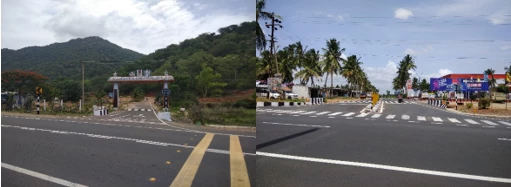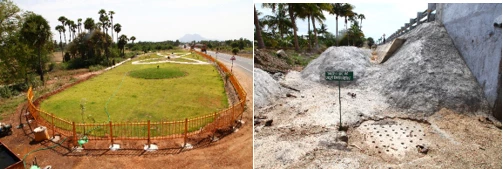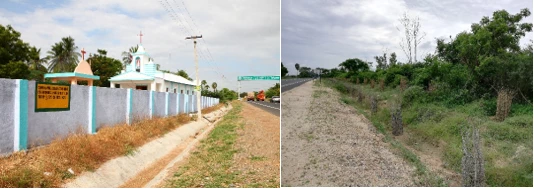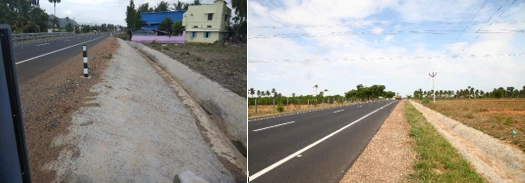
In that context. our ongoing road sector project in the Indian state of Tamil Nadu shows how relatively simple and affordable design improvements can make roads significantly safer, and bring other important benefits such as enhanced drainage and water conservation.
To illustrate this, let’s take a look at 10 key design features that have been included in the project:
1. Treatment of highway sections passing through linear villages / semi-urban stretches with speed calming measures including signs and markings and active measures (rumble strips and speed humps), pedestrian facilities, drainage and paved parking, etc.


2. Bus stops with ramps for passengers with disability, clearly marked out and channelized bus bays and other prominent signs and markings, active speed calming measures, pedestrian guardrails, etc.

3. Combination of signage, metal beam crash barriers, rumble strips and hazard markers on all curves, embankments and approaches to bridges and cross-drainage structures, widening of all narrow cross-drainage structures so that entire roadway is carried on the structures

4. Improvement of all major and minor junctions with adequate signs and markings, channelization, traffic islands and improvement of crossroads up to 100 m away from the junction

5. Protection from all significant roadside hazards (e.g. electric utilities, trees) by crash barriers

6. Use of illuminated raised pavement markers on center and edge lines, delineators, hazard markers, chevrons etc. to facilitate safe driving at night

7. On road stretches cutting through built-up areas, drain with covered footpath and use of paved tiles on the roadside for pedestrian / cyclist movement and parking

8. Environmental enhancement of cultural sites (e.g. temples) and community facilities (e.g. parks, ponds), rain water harvesting, tree plantation, shifting/removal and provision of new electrical poles and lines, water supply lines, etc.


9. Treatment to side slopes and drainage

10. Geometric improvements and overall quality of the highway

All these facilities combined increased construction costs by only about 10% ($100,000 per km)—a worthwhile investment in light of the safety and operational benefits. However, implementing these would not have been possible without meticulous planning, a determined client, capacity building and learning from best practices in other countries, and an engineering, procurement, and construction contracting framework (EPC) with much higher ownership and accountability of the contractor.
The project consultants team included a road safety specialist responsible for flagging vulnerabilities, proposing relevant counter measures, and integrating them into the design of the highway. The International Road Assessment Program (iRAP) carried out a study to identify safety issues along the corridor, which was also used to inform the design of the project. To ensure these provisions are implemented, each is duly embedded in the scope of work of the contract. The EPC works contract required:
- Road Safety Audit of all the design details that have bearing on the safety of users by an independent Safety Consultant. If the safety audit requires any additional work, change in scope will be instructed by the Authority Engineer;
- Deployment of a Qualified Safety Officer and a Safety Supervisor available in the Contractor’s working team for the entire construction period;
- Preparation and submission of a traffic management and safety plan covering safety of users and workers during construction;
- Fulfillment of all required safety measures during construction as per the specifications of the Ministry of Road Transport and Highways;
- Monthly submission of the filled-in Construction Safety Checklist;
- Ensure safe conditions for the users and in the event of unsafe conditions, lane closures, diversions, vehicle breakdowns and accidents, follow relevant operating procedures;
- Maintain and operate a round-the-clock vehicle rescue post to remove damaged vehicles and debris;
- Report all accidents to the Police and to the Authority; and
- Effect and maintain during the Agreement insurances to insure (a) the Contractor’s personnel and (b) any person against any damage, death or bodily injury;
- If the construction work threatens the safety of users and pedestrians, the Authority Engineer can recommend suspension of whole or part of works. Until necessary rectifications are made, works will remain suspended;
- Safety and traffic management is a paid item under the contract;
- Time limits have been set for repair of damaged safety features such as road signs and markings, railing, parapets, crash barriers, pedestrian facilities, retaining walls, road lighting, removal of obstructions to sight, removal of fallen trees, etc. Authority Engineer will undertake site inspections to evaluate compliance; and
- Provisional Certificate for substantial completion of works will not be issued if the project highway or any part thereof cannot be safely and reliably placed in operation.


Join the Conversation